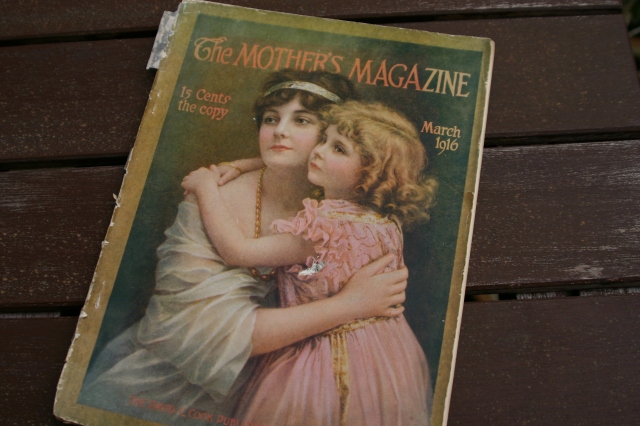I saved this magazine especially for my Mother’s Day post, expecting to find amusing anecdotes highlighting the differences between how we mother today and how our great-grandmothers mothered a century ago. But curiously, blessedly, I couldn’t find much. When it comes to mothering our babies, not a lot has changed. Oh, methods have changed. Medical care has changed. Nutrition has certainly changed. But, looking at the bigger picture, it seems that mothers pretty much want the same things for their children no matter on what year the fluttering calendar pages have come to rest.
I think we can agree that magazines speak to the social concerns and aspirations of the day. Even if the individual reader finds herself unable to live up to those aspirations (like I fail to live up to the standards of Martha Stewart Living), we can still learn what a good portion of the population was aiming for by reading the magazines of the time. And going by this magazine, I’ve realized that our sisters of the early 1900s were a lively, opinionated, caring group of mothers, who put their efforts in to raising their children and running their households to the best of their ability. Is that any different than what I do?
Just like any present-day parenting magazine, the March 1916 issue of The Mother’s Magazine contains articles ranging from broad social concerns to problems that crop up closer to home. Our 1916 mothers read articles on improving the school system and the National Baby Week movement, which aimed to educate parents across the country toward more healthful infant care,ultimately reducing the yearly number of infant fatalities. They also read about more personal concerns, such as coping with interfering mothers-in law, reducing the work load around the house, baby’s hygiene and nutrition, care of a sick child, and the best general parenting methods. They found new recipes to try (a whole article on ways to prepare bacon!), articles on the current fashions, and many, many advertisements–all selling ways to bring up a superior child, improve their looks, boost their health, and make a little money on the side. Sounds awfully familiar, doesn’t it?
Some of it is beautifully written and spot-on applicable to my own mothering, making me forget that I am reading something vintage. Instead, I find myself reading with the intent of applying it to my own family. On page 65, I read:
The Sunshine, by Margaret Blaine
The child’s character in future years will reflect just as much sunshine and cheer as surrounded him from the earliest days. We recognize unthinkingly that the child is a reflection of his surroundings. The whining child lives with irritable people. The rude child is not treated courteously. We recognize the beloved child at once. Whatever of strength or weakness may be hidden in the child’s heart his manners and mannerisms, the habits that will make him attractive or the reverse, are the reflections of his surroundings. No child speaks a harsh word until he has heard one. No child lies, in the essential meaning of the term, if he is brought up in an atmosphere of kindness. And the beginning of this silent training is in the very beginning of his life. Love and truth must wrap the cradle. Firmness and self-control must be the mother’s while the babe yet sleeps in her arms.
On another page, I found myself laughing out-loud with Elna H. Wharton, when she writes:
When baby was tiresome or unmanageable he was my child; when he was cunning or unusually handsome, he was “John’s baby” or “my grandchild.” I came to discover that my mother-in-law’s devotion to our baby was purely selfish. She did for it what gave her personal gratification, and skipped nimbly out of the way of any of the hard, disagreeable tasks connected with his care. It wasn’t that I wanted her to do them; it was only that the sentimentality without real service finally got on my nerves.
Nothing out-of-date about that!
Of course there were some things here and there that gave me pause. From the aforementioned bacon article, I give you a recipe for–wait for it–Calf’s Head with Bacon. They say bacon makes any dish good, but I’ll let you be the judge of that.
Calf’s Head with Bacon
Take half a calf’s head, remove the brain carefully, wash it in cold water, and put it in a basin of water with a little vinegar. Wash the calf’s head in salted water, then boil it in seasoned water or stock and cook till tender, together with a piece of lean bacon. Take up the head, drain, and serve with slices of boiled bacon. Serve with brain sauce.
Are you now wondering how to make ‘brain sauce’? Keep reading!
Brain Sauce
Drain the brain mentioned in the foregoing recipe, remove the skin, and put it in a saucepan with enough water to cover, adding one-fourth teaspoonful of salt. Boil up quickly and place in cold water, then drain again and chop it finely. Now add the chopped brain to one cupful of white sauce. Season to taste and serve.
Hmmmm… I think I’ll save that recipe for Father’s Day! Happy Mother’s Day, everyone.


This was really good! Your posts get better each time! I love how your encorperating humour to a a good subject! Happy Early-Mothers day Mom!
Thank you, Derek! When do I get to read YOUR blog? 🙂
I love the line, “We recognize the beloved child at once.” I hope my children are beloved. Happy Mother’s Day! Looks like you’ve got a great son. 🙂
That line struck me as well, Momsicle. (And I can tell by your writing that your children are beloved. 🙂 ) And you are right–I do have a great son. A great daughter, too. We are truly blessed. Have a wonderful day and thanks for stopping by.
I love Margaret Blaine’s description of children. So true.
Me too. So beautifully said, and so relevant for today.